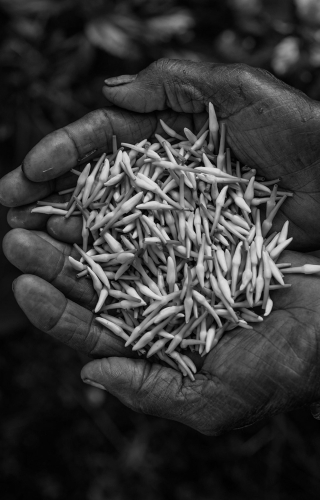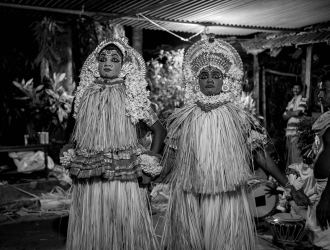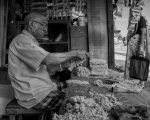Situated three km east of NH 17, Shankarapura lies between the towns of Katapadi and Shirva, in Udupi district, Karnataka. A blink-and-miss place, it has little to interest a casual passer-by. However, this nondescript town is the jasmine capital in Dakshin Kannada.
Jasmine has many names in India, among them juhi, mogra and chameli are well known. In Karnataka, the jasmine flower is called mallige. Three species of jasmine are cultivated in Karnataka, in three different regions. Of them, Mysore mallige (Jasminum trifoliatum) is the most famous, grown in Mandya district. The second species is Hadagalli mallige (Jasminum azoricum) grown in Bellary district, and the third is Udupi mallige (Jasminum sambac), grown in Shankarapura, and surrounding villages of Pangala, Kurlkal, Moodubettu, Innanje and Shirva.
For weddings in the Konkan region—irrespective of religion—jasmine strings are used to decorate the bride. Even in daily life, jasmine strings are worn by women in their hair. Jasmine is used daily in temples, at festivals like Buta Kola, prayer alters in homes, and at religious shrines. A large market also caters to the production of perfumes, incenses, essential oils and other commercial items. Jasmine tea is also popular as a green tea variety and is used in the medicine industry and Ayurveda. Udupi mallige’s suitability to the laterite soil and the humid weather of the region contributes to its characteristic strong fragrance, white colour and large size. This has earned it a Geographical Indication (GI) tag.
Udupi mallige came to be cultivated by the Christian community of Shankarapura. Reverend Basil Salvadore Peres (later to be bishop of Mangalore) was sent to Pangla as the new chaplain on April 14, 1934. Most of the topography being hilly, Father Peres encouraged the people of Pangla to cultivate jasmine. Eventually, jasmine cultivation became a lucrative source of revenue for the community. Authorities realised mallige cultivation was conducive to local rural economy, hence promoted its cultivation on unused lands. Today, almost every household in Shankarapura depends on jasmine cultivation for their livelihood.
As the bus conductor shouted Shankarapura, I got down to find nothing but a few small shops and an auto-rickshaw stand. One of the shops was the katte (loosely translated to adda or a place to hangout), the centre of jasmine business. The owner of this place, Mr Vincent Rodriguez, was busy ensuring the jasmine flowers remain fresh and ready for distribution. In Shankarapura, there are four jasmine kattes selling to wholesalers and retailers. Here traders sit together to calculate the price that they will be paying the farmers. The price is determined based on the demand from their prospective wholesalers, and bulk orders are given well in advance by the agents.
Mr Vincent was kind enough to put me in touch with local jasmine cultivators. One of the major farmers in the area is Mrs Jilly Bai. She wakes up before sunrise and gets to tending the plants. She said, ‘The jasmine buds need to be picked before the sun touches them so they remain fresh.’ Freshness of the flower is a key factor in its fragrance. She says, ‘Business from these flowers has given my children a good schooling, and I have managed to repay my bank loans.’ She takes her routine seriously, and it takes her about 2–3 hours to pick the flowers.
Walking further into the village on narrow mud roads, I found 75-year-old Agnes Rodrigues. Her brother is the priest at the local church. Agnes learnt the picking skills from her mother. Her family once owned a large piece of land, which was used for jasmine cultivation, but with growing age and lack of labour, she decided to part ways with a large part of the land and kept just a small patch as a memory of days gone by. Waking up early and picking up flowers has been her first chore of the day for the last 50 years. Open flowers are generally not harvested as a large amount of them is needed to extract oils and they lose their fragrance sooner.
Not every family in Shankarapura is involved in jasmine cultivation. Some households are tasked to string the jasmine buds using threads made from plantain bark. This takes considerable skill, and those who make these strings, have perfected it since childhood. I met Teresa Quadras and Nancy Quadras, mother-in-law and daughter-in-law duo. They were sitting outside their house, stringing flowers. They told me, ‘Our strings need to be ready before the agents from the Katte send their guys to pick them up.’ I asked, ‘What if you are late?’ ‘Then you have to go to the Katte yourself or forget the earnings for the day,’ said Nancy. Teresa added, ‘We have never been late in all these years. We understand that it is important for everything to happen in time. Breakfast can wait, but the flowers won’t, they just bloom.’
At around 9:30 am, Ahmed, in his late 50s, arrived from the katte riding his old motorbike. His job is to go from house to house collecting flower chains and bringing them to the katte. He claims to have been doing this job for about 40 years. He gave me a ride on his bike on the bumpy roads. Most houses he stopped by, had a designated place to keep the flowers, with a paper chit attached to the string. This chit has details that inform the traders at the katte about who supplied the flowers, so they can be paid accordingly.
Once the flower chains reach the Katte, they are segregated according to size. They are then wrapped in banana leaves, and ready to travel to cities within Dakshin Kannada and Upudi districts. The flowers leave the katte by 10:30 to 11:00. Vincent added, ‘We are literally running against time. The flowers need to reach the end consumer before they bloom. If they don’t, the price drops considerably.’ From places like Mangalore, they are exported to other states in South India, and sometimes even Dubai. Mumbai is a major destination. On long travels, the flowers are refrigerated so they last up to three days. However, refrigeration for long periods can cause significant loss of fragrance and texture, which makes the flower lose value in the market.
Even though demand for Udupi mallige is high, over the years, interest in jasmine cultivation has declined due to the shortage of labour caused by local migration to Gulf countries. In 2020, the Covid-19 pandemic and the nationwide lockdown hit the jasmine cultivation industry like a tsunami. Ban on social gatherings, festivals, closure of markets and long-distance transportation brought the industry to a grinding halt. Even though demand plummeted, the jasmine had to be plucked daily, but with no buyers, they wasted. Old cultivators like Joseph Castalino hold the fort, saying, ‘The jasmine shrubs have taken care of us in difficult times. They gave me and my family a better life. I don’t have the heart to abandon them.’ Most jasmine farmers share a similar emotional bond with the plants. They hope the market will bounce back from the crisis in 2021, and the Udupi mallige will regain its famed fragrance.
This photo-essay has been created as part of the Sahapedia Frames Photography Grant, supported by CSR funding from IndusInd Bank.

















